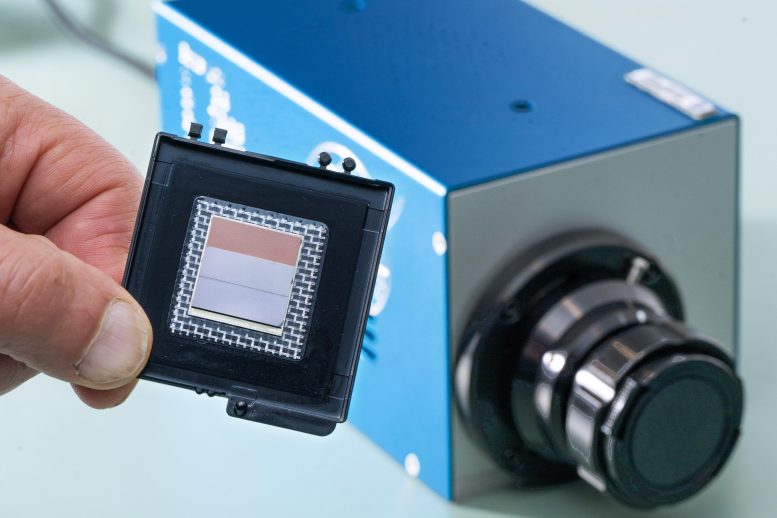New Infrared Cameras Revealed by NASA for Earth and Space Exploration

NASA engineer Murzy Jhabvala presents his creation, the Compact Thermal Imager camera technology, a high-resolution, high-spectral range infrared sensor geared for small satellites and solar-system exploration missions. Credit: NASA
New infrared sensor technology created by NASA boosts resolution for both Earth and space imagery, which could lead to advancements in environmental monitoring and planetary exploration.
The newly invented infrared camera, equipped with high resolution and a set of lightweight filters, has the potential to analyze sunlight reflection from Earth’s upper atmosphere and surface, enhance alerts for forest fires, and decipher the molecular composition of other planets.
The new cameras include sensitive, high-resolution strained-layer superlattice sensors, which originated from NASA’s Goddard Space Flight Center in Greenbelt, Maryland, with funding from the Internal Research and Development (IRAD) program.
Due to their compact nature, lightweight construction, and versatility, engineers such as Tilak Hewagama can tailor these cameras for a variety of scientific applications.
Hewagama stated, “The addition of filters directly onto the detector eliminates the substantial weight of traditional lens and filter systems." He adds, "This paves the way for a lightweight instrument with a compact focus plane, which can now be cooled for infrared detection using smaller and more efficient cooling systems. Smaller satellites and missions can greatly benefit from their superior resolution and precision.”
Engineer Murzy Jhabvala initiated the first sensor development at NASA’s Goddard Space Flight Center in Greenbelt, Maryland, and he continues to lead the ongoing filter integration ventures.
Beyond initial development, Jhabvala led the Compact Thermal Imager experiment aboard the International Space Station. This demonstrated the new sensor technology's capability to withstand space conditions and its potential as a significant asset for Earth science. Over 15 million images captured in two infrared bands garnered Jhabvala and his NASA Goddard colleagues, Don Jennings and Compton Tucker, the prestigious Invention of the Year award for 2021.
The Compact Thermal Imager was successful in documenting unusually severe fires in Australia from its position on the International Space Station in 2019 and 2020. Offering high-resolution imagery, it accurately determined the shape and location of the fires and their distance from populated areas. This critical information was invaluable to first responders. Credit: NASA
The data from the test offered detailed insights about wildfires, as well as improved understanding of the Earth’s cloud and atmospheric structure. It even captured a gravity wave caused by the wind lifting off Earth's land features.
These pioneering infrared sensors use layers of repeating molecular structures to interact with individual units of light, or photons. The sensors can discern more wavelengths of infrared at a higher resolution, compared to other thermal cameras.
The effective performance of these thermal cameras has prompted investments from NASA’s Earth Science Technology Office, Small Business Innovation and Research program, and other initiatives to maximize their application.
Jhabvala and NASA’s Advanced Land Imaging Thermal IR Sensor team are currently producing a six-band version for the upcoming LiDAR, Hyperspectral, & Thermal Imager project. He said, this unique camera will measure surface heat and enable pollution surveillance and fire observations at high capture speeds.
NASA Goddard Earth scientist Doug Morton heads an initiative creating a Compact Fire Imager for timely wildfire detection and prediction.
“The frequency of fires isn't expected to decline, thus we aim to understand the energy release patterns of fires over their lifespan,” Morton stated. “This knowledge would allow us to better adapt to an increasingly fire-prone world.”
CFI will monitor the most severe fires, which release more greenhouse gases, and the cooler, smoky remnants, which emit higher amounts of carbon monoxide and airborne particles like smoke and ash.
“Understanding these elements is crucial for safety and understanding the greenhouse gases emitted during a burn,” said Morton.
Following the fire imager tests on airborne campaigns, Morton envisions the deployment of ten small satellites to generate global fire related information with more frequent imagery.
Morton adds that, in tandem with next-generation computer models, "this information could assist forest services and other firefighting agencies in preventing fires, improving firefighter safety, and protecting the lives and properties of people living in fire prone areas.”
Outfitted with polarization filters, the sensor could measure how ice particles in Earth’s upper atmosphere clouds scatter and polarize light, NASA Goddard Earth scientist Dong Wu said.
This applications would complement NASA’s PACE — Plankton, Aerosol, Cloud, ocean Ecosystem — mission, Wu said, which revealed its first light images earlier last month. Both measure the polarization of light wave’s orientation in relation to the direction of travel from different parts of the infrared spectrum.
“The PACE polarimeters monitor visible and shortwave-infrared light,” he explained. “The mission will focus on aerosol and ocean color sciences from daytime observations. At mid- and long-infrared wavelengths, the new Infrared polarimeter would capture cloud and surface properties from both day and night observations.”
In another effort, Hewagama is working Jhabvala and Jennings to incorporate linear variable filters which provide even greater detail within the infrared spectrum. The filters reveal atmospheric molecules’ rotation and vibration as well as Earth’s surface composition.
That technology could also benefit missions to rocky planets, comets, and asteroids, planetary scientist Carrie Anderson said. She said they could identify ice and volatile compounds emitted in enormous plumes from Saturn’s moon Enceladus.
“They are essentially geysers of ice,” she said, “which of course are cold, but emit light within the new infrared sensor’s detection limits. Looking at the plumes against the backdrop of the Sun would allow us to identify their composition and vertical distribution very clearly.”




